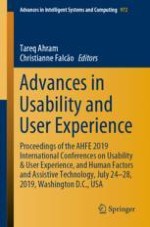This book focuses on emerging issues in usability, interface design, human–computer interaction, user experience and assistive technology. It highlights research aimed at understanding human interaction with products, services and systems, and focuses on finding effective approaches for improving user experience. It also discusses key issues in designing and providing assistive devices and services to individuals with disabilities or impairment, to assist mobility, communication, positioning, environmental control and daily living. The book covers modelling as well as innovative design concepts, with a special emphasis on user-centered design, and design for specific populations, particularly the elderly. Virtual reality, digital environments, heuristic evaluation and forms of device interface feedback of (e.g. visual and haptic) are also among the topics covered. Based on the both the AHFE 2019 Conference on Usability & User Experience and the AHFE 2019 Conference on Human Factors and Assistive Technology, held on July 24-28, 2019, Washington D.C., USA, this book reports on cutting-edge findings, research methods and user-centred evaluation approaches.
